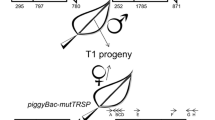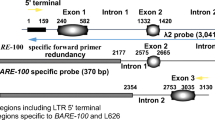Summary
The two components of theBg-rbg transposable element system of maize have been cloned. TheBg element, isolated from the mutable allelewx-m32 :: Bg is inserted in the intron of theWaxy (Wx) gene between exons 12 and 13. The length of the element is of 4869 bp.Bg has 5 by terminal inverted repeats, and generates upon insertion an 8 by direct duplication of the target sequence. Both ends of theBg element contain a 76 by direct repeat adjacent to the terminal inverted repeats. The hexamer motif TATCGkC G is here repeated several times in direct or inverse orientation. Therbg element was isolated from the mutable alleleo2m(r) where it is located in the promoter region of theOpaque-2 (O2) gene.rbg is approximately 4.5 kb in length, has terminal inverted repeats identical to those of theBg element, and is also flanked by an 8 by direct duplication at the target site. LikeBg, rbg carries the 76 by direct repeats. Restriction enzyme analysis reveals that, compared toBg, the receptor element is distinguishable by small deletion and insertion events. Sequence data indicate that not more than 75% homology exists at the DNA level between therbg element and the autonomousBg element.
Similar content being viewed by others
References
Benton WD, Davis RW (1977) Screening lambda gt recombinant clones by hybridization to single plaquesin situ. Science 196:180–182
Bonas U, Sommer H, Saedler H (1984) The 17 kbTam1 element ofAntirrhinum majus induces a 3 by duplication upon integration into the chalcone synthase gene. EMBO J 3:1015–1019
Breathnach R, Chambon P (1981) Organization and expression of eucaryotic split genes coding for proteins. Annu Rev Biochem 50:349–383
Clewell DB, Helinski DR (1969) Supercoiled circular DNA-protein complex inE. coli: purification and induced conversion to an open circular DNA form. Proc Natl Acad Sci USA 62:1159–1166
Döring HP, Starlinger P (1986) Molecular genetics of transposable elements in plants. Annu Rev Genet 20:175–200
Fedoroff N (1983) Controlling elements in maize. In: Shapiro J (ed) Mobile genetic elements. Academic Press, New York, pp 163
Fickett JW (1982) Recognition of protein coding regions in DNA sequences. Nucleic Acids Res 10:5303–5318
Frischauf AM, Lehrach H, Poutska P (1983) Lambda replacement vectors carrying polylinker sequences. J Mol Biol 170:827–842
Gerats AGM, Huits H, Vrijlandt E, Marana C, Souer E, Beld M (1990) Molecular characterization of nonautonomous transposable element (dTph1) of Petunia. Plant Cell 2:1121–1128
Gierl A, Saedler H (1989) TheEn/Spm transposable element ofZea mays. Plant Mol Biol 13:261–266
Hartings H, Maddaloni M, Lazzaroni N, Di Fonzo N, Motto M, Salamini F, Thompson R (1989) TheO2 gene which regulates zein expression in maize endosperm encodes a protein with structural homologies to transcriptional activators. EMBO J 8:2795–2801
Hartings H, Lazzaroni N, Ajmone Marsan P, Aragay A, Thompson R, Salamini F, Di Fonzo N, Palau J, Motto M (1990) The b-32 protein from maize endosperm: characterization of genomic sequences encoding two alternative central domains. Plant Mol Biol 14:1031–1040
Hermann A, Schulz W, Hahlbrock K (1988) Two alleles of the single-copy chalcone synthase gene in parsley differ by a transposon-like element. Mol Gen Genet 212:93–98
Joshi CP (1987) An inspection of the domain between putative TATA box and translation start site in 79 plant genes. Nucleic Acids Res 15:6643–6653
Köster-Töpfer M, Frommer WB, Rocha-Sosa M, Willmitzer L (1990) Presence of a transposon-like element in the promoter region of an inactive patatin gene inSolanum tuberosum L. Plant Mol Biol 14:239–247
Kozak M (1984) Compilation and analysis of sequences upstream from the translational start site in eucaryotic mRNAs. Nucleic Acids Res 12:857–872
Kunze R, Starlinger P (1989) The putative transposase of transposable elementAc fromZea mays L. interacts with subterminal sequences ofAc. EMBO J 8:3177–3185
Kunze R, Starlinger P, Schwartz D (1987) DNA methylation of the maize transposable element Ac interferes with its transcription. Mol Gen Genet 214:325–327
Maniatis T, Fritsch EF, Sambrook J (1982) Molecular cloning: a laboratory manual. Cold Spring Harbor Laboratory, Cold Spring Harbor, New York
Marotta R, Ponziani G, Motto M, Hartings H, Gierl A, Di Fonzo N, Soave C, Bianchi A, Salamini F (1986) Genetic instability at theshrunken andwaxy loci in theo2-m(r)-Bg strain of maize. Maydica 31:131–151
McClintock B (1949) Mutable loci in maize. Carnegie Inst Washington Year Book 48:142–154
McClintock B (1950) The origin and behavior of mutable loci in maize. Proc Natl Acad Sci USA 36:344–355
McClintock B (1951) Chromosome organization and genic expression. Cold Spring Harbor Symp Quant Biol 16:13–47
Montanelli C, Di Fonzo N, Marotta R, Motto M, Soave C, Salamini F (1984) Occurrence and behaviour of the componentso2m(r)-Bg system of maize controlling elements. Mol Gen Genet 197:209–218
Motto M, Maddaloni M, Ponziani G, Brembilla M, Marotta R, Di Fonzo N, Soave C, Thompson R, Salamini F (1988) Molecular cloning of theo2-m5 allele ofZea mays using transposon marking. Mol Gen Genet 212:488–494
Motto M, Thompson R, Di Fonzo N, Ponziani G, Soave C, Maddaloni M, Hartings H, Salamini F (1989) Transcriptional ability of theBg-rbg system of maize transposable elements. Maydica 34:107–122
Müller-Neumann M, Yoder JI, Starlinger P (1984) The DNA sequence of the transposable elementAc ofZea mays L. Mol Gen Genet 198:19–24
Pereira A, Cuypers H, Gierl A, Schwarz-Sommer Zs, Saedler H (1986) Molecular analysis of theEn/Spm transposable element system ofZea mays. EMBO J 5:835–841
Peterson PA (1986) Mobile elements in maize: a force in evolutionary and plant breeding processes. In: Gustafson JB, Stebbins GL, Ayala FJ (eds) Genetics, development and evolution. Plenum, New York, pp 47–78
Pohlman RF, Fedoroff NV, Messing J (1984) The nucleotide sequence of the maize controlling element Activator. Cell 37:635–643
Rhodes PR, Vodkin LP (1988) Organization of theTgm family of transposable elements in soybean. Genetics 120:597–604
Rigby PW, Diechmann M, Rhoades C, Berg P (1977) Labelling of deoxyribonucleic acid to high specific activityin vitro by nick translation with DNA polymerase. J Mol Biol 113:237–251
Salamini F (1980) Genetic instability at theOpaque-2 locus of maize. Mol Gen Genet 179:497–507
Salamini F (1981) Controlling elements at theOpaque-2 locus of maize: their involvement in the origin of spontaneous mutations. Cold Spring Harbor Symp Quant Biol 45:467–476
Sanger F, Nicklen S, Coulson AR (1977) DNA sequencing with chain terminating inhibitors. Proc Natl Acad Sci USA 74:5463–5467
Schmidt RJ, Burr FA, Burr B (1987) Transposon tagging and molecular analysis of the maize regulatory locusopaque-2. Science 238:960–963
Sehgal A, Patil N, Chao M (1988) A constitutive promoter directs expression of the nerve growth factor receptor gene. Mol Cell Biol 8:3160–3167
Upadhyaya KC, Sommer H, Krebbers E, Saedler H (1985) The paramutagenic line niv-44 has a 5′ kb insert, Tam2, in the chalcone synthase gene ofAntirrhinum majus. Mol Gen Genet 199:201–220
Yamamoto KR, Alberts BM, Benzinger R, Lawhorne L, Treiber G (1970) Rapid bacteriophage sedimentation in the presence of polythylene glycol and its application to large-scale virus purification. Virology 40:734–744
Author information
Authors and Affiliations
Additional information
Communicated by H. Saedler
Rights and permissions
About this article
Cite this article
Hartings, H., Spilmont, C., Lazzaroni, N. et al. Molecular analysis of theBg-rbg transposable element system ofZea mays L.. Molec. Gen. Genet. 227, 91–96 (1991). https://doi.org/10.1007/BF00260712
Received:
Issue Date:
DOI: https://doi.org/10.1007/BF00260712




